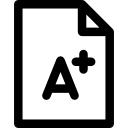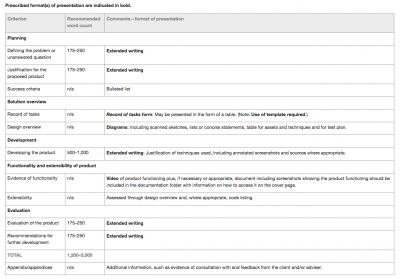Internal Assessment: Difference between revisions
Mr. MacKenty (talk | contribs) |
|||
| (37 intermediate revisions by 2 users not shown) | |||
| Line 2: | Line 2: | ||
== Introduction == | == Introduction == | ||
I use this excellent summary from compscihub.net<ref>https://ib.compscihub.net/internal-assessment/overview</ref> | |||
The Internal Assessment component (IA) accounts for 30% of the Standard Level grade and 20% of the Higher Level Grade. There are a maximum of 34 marks to be earned. | |||
The IA consists out of 5 parts and can be no longer than 2000 words (excluding any appendixes & footnotes/bibliographies). The video can be no longer than 7 minutes. | |||
* Criterion A – Planning – 6 marks | |||
* Criterion B – Record of Tasks (RoT) and Design – 6 marks | |||
* Criterion C – Development – 12 marks | |||
* Criterion D – Functionality (Video) – 4 marks | |||
* Criterion E – Evaluation – 6 marks | |||
== Helpful links == | |||
* Please [https://docs.google.com/document/d/1HaLijvMZX0gWJgEcJt4NlIUmPxF4raN-UdZAvHUI31M/edit click here for a checklist to help you stay organized]. | |||
* Please [[:media:IA assessment criteria.pdf|Click here to see the IA assessment criteria]] | |||
* [[:File:Forms.zip| Your solution must be formatted precisely. Click this link for a compressed folder with the templates.]] | |||
** Please make sure you include section b AND section b record of tasks - these should be two separate files. | |||
** Please make sure your code is in the '''Product''' folder in plaintext so examiners can copy/paste code as needed. | |||
** Please watch this video for instructions to format your project: https://youtu.be/ezKDs4SWwWc | |||
== Exemplars == | |||
Exemplars are available from your teacher | |||
== The Solution == | == The Solution == | ||
| Line 17: | Line 31: | ||
The requirement of the internal assessment is to develop a solution for a specified client to a specified problem or an unanswered question. | The requirement of the internal assessment is to develop a solution for a specified client to a specified problem or an unanswered question. | ||
== | == Example of previous IA topics == | ||
* Interactive fiction creator | |||
* Personal budget tool | |||
* A web-based program that finds the best price for a food item in Warsaw. Limit food choices to 25 items. | |||
* A web-based program to manage exercise goals, exercise targets | |||
* a web based php text-based game | |||
* A locally-installed python script that perfroms network analysis tool that helps users clearly understand what might be wrong with a network connection application snooper (little snitch) | |||
* Arranging meeting time with counselors using google calendar API | |||
* A web-based program to automatically creates brackets for clubs and team events | |||
* A web-based program that makes scheduling free time with a teacher easier. | |||
* A google chrome extension that tracks how much time is wasted by a user | |||
* A web-based program to help students understand what school they might be accepted to with their GPA | |||
* A game to help users who are using assistive technologies | |||
* An event management system | |||
* tool to allocate billable hours | |||
* Application to analyze facial type | |||
* Sorting program for shoes | |||
* Application to help me with habits | |||
* A program for roomate best-fit algorithm | |||
* Application to help teachers remember students | |||
* An inventory management system | |||
* Application to make a computer science search engine | |||
* Application to help people manage event | |||
* Application to rationally play hearthstone | |||
* Application for facial recognition to make eye shadow | |||
== Key terms == | == Key terms == | ||
* The term “solution” refers to all the work submitted by the student for the internal assessment; the term “product” refers to the completed software only. The product is a subset of the solution. | * The term “solution” refers to all the work submitted by the student for the internal assessment; the term “product” refers to the completed software only. The product is a subset of the solution. | ||
* The terms “developer” and “student” are synonymous. | * The terms “developer” and “student” are synonymous. | ||
* The term “client” refers to the person for whom the product is being developed | * The term “client” refers to the person for whom the product is being developed. | ||
* The term “adviser” refers to a third party the student must identify to assist him or her in the development of the product. | * The term “adviser” refers to a third party the student must identify to assist him or her in the development of the product. | ||
| Line 51: | Line 76: | ||
* [[The solution documentation | supporting documentation (word limit 2,000 words)]] | * [[The solution documentation | supporting documentation (word limit 2,000 words)]] | ||
=== Word count === | |||
Bullet list of success criteria is not included in overall word count. However, if bullet list contains an extended writing, then that text will be included in word count. | |||
<br /> | |||
[[File:Word count.png|400px]] | |||
== References == | == References == | ||
Latest revision as of 15:33, 12 February 2023

Internal Assessment[1]
Introduction[edit]
I use this excellent summary from compscihub.net[2]
The Internal Assessment component (IA) accounts for 30% of the Standard Level grade and 20% of the Higher Level Grade. There are a maximum of 34 marks to be earned.
The IA consists out of 5 parts and can be no longer than 2000 words (excluding any appendixes & footnotes/bibliographies). The video can be no longer than 7 minutes.
- Criterion A – Planning – 6 marks
- Criterion B – Record of Tasks (RoT) and Design – 6 marks
- Criterion C – Development – 12 marks
- Criterion D – Functionality (Video) – 4 marks
- Criterion E – Evaluation – 6 marks
Helpful links[edit]
- Please click here for a checklist to help you stay organized.
- Please Click here to see the IA assessment criteria
- Your solution must be formatted precisely. Click this link for a compressed folder with the templates.
- Please make sure you include section b AND section b record of tasks - these should be two separate files.
- Please make sure your code is in the Product folder in plaintext so examiners can copy/paste code as needed.
- Please watch this video for instructions to format your project: https://youtu.be/ezKDs4SWwWc
Exemplars[edit]
Exemplars are available from your teacher
The Solution[edit]
The requirement of the internal assessment is to develop a solution for a specified client to a specified problem or an unanswered question.
Example of previous IA topics[edit]
- Interactive fiction creator
- Personal budget tool
- A web-based program that finds the best price for a food item in Warsaw. Limit food choices to 25 items.
- A web-based program to manage exercise goals, exercise targets
- a web based php text-based game
- A locally-installed python script that perfroms network analysis tool that helps users clearly understand what might be wrong with a network connection application snooper (little snitch)
- Arranging meeting time with counselors using google calendar API
- A web-based program to automatically creates brackets for clubs and team events
- A web-based program that makes scheduling free time with a teacher easier.
- A google chrome extension that tracks how much time is wasted by a user
- A web-based program to help students understand what school they might be accepted to with their GPA
- A game to help users who are using assistive technologies
- An event management system
- tool to allocate billable hours
- Application to analyze facial type
- Sorting program for shoes
- Application to help me with habits
- A program for roomate best-fit algorithm
- Application to help teachers remember students
- An inventory management system
- Application to make a computer science search engine
- Application to help people manage event
- Application to rationally play hearthstone
- Application for facial recognition to make eye shadow
Key terms[edit]
- The term “solution” refers to all the work submitted by the student for the internal assessment; the term “product” refers to the completed software only. The product is a subset of the solution.
- The terms “developer” and “student” are synonymous.
- The term “client” refers to the person for whom the product is being developed.
- The term “adviser” refers to a third party the student must identify to assist him or her in the development of the product.
3 scenarios in developing a product[edit]
- The student is developing the product for a third party who is the client and also acts as the adviser.
- The student is developing the product for a third party who is the client. Another person acts as the adviser.
- The student is the client (developing the product for himself or herself). An appropriate adult must act as the adviser.
Requirements of the solution[edit]
- a cover page that follows the prescribed format
- a product
- supporting documentation (word limit 2,000 words)
Word count[edit]
Bullet list of success criteria is not included in overall word count. However, if bullet list contains an extended writing, then that text will be included in word count.
